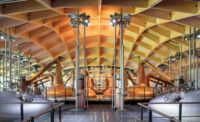The redevelopment of Manhattan’s Ground Zero moves one step closer to conclusion today with a ribbon cutting at 3 World Trade Center (WTC), the third office tower to be completed on the 16-acre WTC site. At 1,079 feet, the 80-story glass skyscraper, designed by Rogers Stirk Harbour + Partners and developed by Silverstein Properties, will rank as the second tallest in the WTC complex (behind Skidmore, Owings & Merrill’s One WTC), and the fifth tallest in the city.
The reportedly $2.7 billion, 2.5 million-square-foot project features a stepped shaft that rises from a 250-foot podium. It has a robust structure that includes a reinforced concrete core—with walls that are 5 feet thick at the base—and a steel load-sharing system around the perimeter. On the east and west facades, vertical K-bracing provides extra stiffness, according to Rogers Stirk + Harbour partner Richard Paul. This expressed structure makes 3 WTC appear relatively brawny compared to its immediate neighbor, the more visually quiet 4 WTC designed by Maki and Associates.
The muscular aesthetic continues inside 3 WTC’s lobby with a palette predominantly of white, gray, and black, including a sleek onyx reception desk, a granite floor, and walls clad in panels that at first glance appear to be brushed metal. Instead they are fabric laminated behind glass. Overhead is a 42-foot-high illuminated ceiling of stretched PVC.
The office levels above are a “complete blank canvas,” making them suitable for almost any kind of tenant, according to Paul. The flexibility is a product of the building’s structural system, which floor plates that range from 31,000 to 70,000 square feet without columns intervening between the core and perimeter. Other enticements for prospective tenants are the building’s views of the city, in particular from its outdoor terraces at levels 17, 60, and 76.
These amenities, and the adaptability in particular, could prove to be critical to the project’s success, especially since the design first unveiled almost 12 years ago when target market was the financial services industry. So far 3 WTCs primary occupants are technology, advertising, and branding companies. As of late May, 38 percent of the tower had been leased, and the largest tenant, with 700,000 square feet, is GroupM. The media company will start moving into its HOK-designed offices on nine floors in July.
With 3 WTC’s completion, only a few unfinished components of Studio Daniel Libeskind’s 2003 master plan for the World Trade Center site remain: An arts venue that was originally to have been designed by Gehry Partners, is finally under construction with a scheme by REX, after years of uncertainty. The below-grade structure of the last office tower, 2 WTC, has been completed, but continuation of construction will depend on market demand. The original design, by Foster + Partners, has since been replaced with one by Bjarke Ingels Group.





